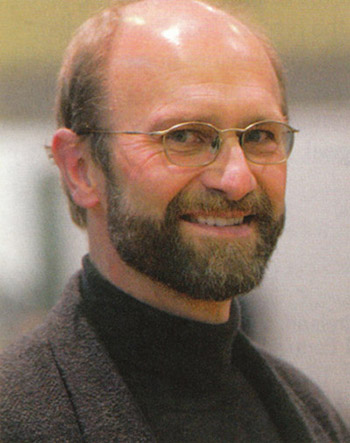
by Ludwig Christmann
(this article originally appeared in the April 2020 edition of Der Hannoveraner
and is re-produced with permission)
There is a lot of interest in Dutch genetics, especially with respect to dressage horses. So there are good reasons to take a closer look at KWPN dressage horse breeding.
What is the origin of the breed?
The Netherlands was home to two warmblood breeds. The Groninger was bred in the north and was similar to other European breeds, the Altoldenburger and the Ostfriesen. The Gelderlander was bred in the south, its build is lighter. It was originally used as a workhorse for agriculture and as a cart horse.
After World War II, as mechanization in society and agriculture gained momentum and equestrian sports increased in popularity, these horses were also used under saddle.
“The Gelderlander was a real all-rounder: for work in the countryside, at the weekend for riding in dressage, jumping or eventing, and, on Sundays, as a means to get to church. Its characteristics were just as versatile: a strong horse with a good walk and trot with a lot of flexion in the joints and a sublime front leg technique with a lot of shoulder freedom and knee action.”
At the time, the selection process for character and willingness to perform already existed: “People parted with horses that did not want to work,” is how Johan Hamminga, a dressage trainer up to the Grand Prix-level and a member of the KWPN licensing commission, describes the Gelderlander.
According to literature (Wikipedia), the Andalusian, Neapolitan, Anglo-Norman breeds as well as Norfolk Trotters are mentioned as breeds that influenced the Gelderlander. The latter breed, which originated in England, has also influenced various trotter breeds, among others.
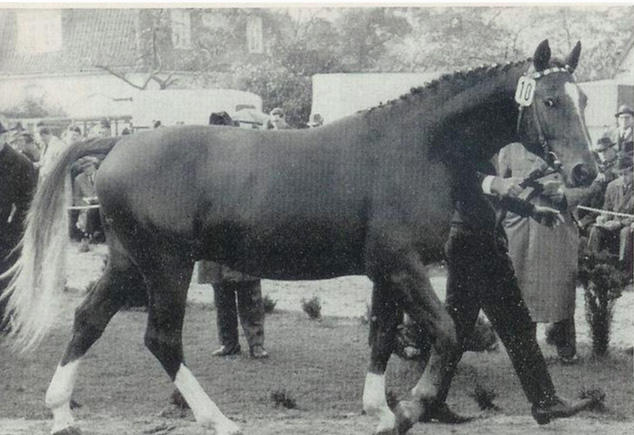
Eclatant – Hannoverian influence in The Netherlands
Changing the breeding process towards creating riding horses began as early as the 1950s with imported stallions such as the Anglo-Norman, L‘Invasion, or the Holstein, Normann, and later Amor, to name a few. But also the Hannoveraner, Eclatant by Duellant/Ableger out of the mare line of Nehrung (breeder: Claus Schmoldt, Hollerdeich) played a role.
Eclatant was born in 1963, and sold to the Netherlands at Verden’s stallion sales in 1965. In the 06/1965 issue of ‘Hannoversches Pferd’, he is described as a “strong stallion with a very steadfast character, a short cannon-bone and very good, swinging movements.”
In 1969, the existing studbooks merged and the Royal Warmblood Studbook of the Netherlands (KWPN) was founded. Since 2006, there have been four official breeding directions: the dressage horse, the show-jumping horse, the carriage horse and the Gelder horse.
Doruto – one of the first of the dressage sires…
Gribaldi, Totilas was his most famous son
Foreign genetics were heavily used In the development of the dressage and showjumping breeding lines: Trakehner stallions such as Doruto (born 1962 by Komet) and Gribaldi (born 1993 by Kostolany), Holstein stallions such as Flemmingh (born 1987 by Lacapo), Selle Français stallions such as Le Mexico (born 1970 by Mexico who was a full brother of Furioso II), but also Hannoveraner stallions were used.
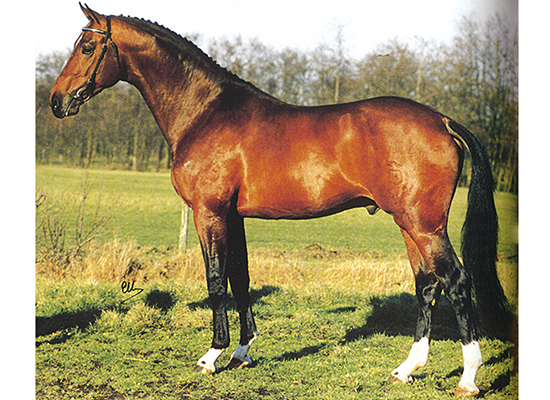
Flemmingh – one of the important Holsteiner imports
Especially Voltaire by Furioso II/Gotthard (born in 1979; breeder: Erika Kuwert, Mülheim), had a strong, positive influence on the development of the breeding of Dutch show jumpers.
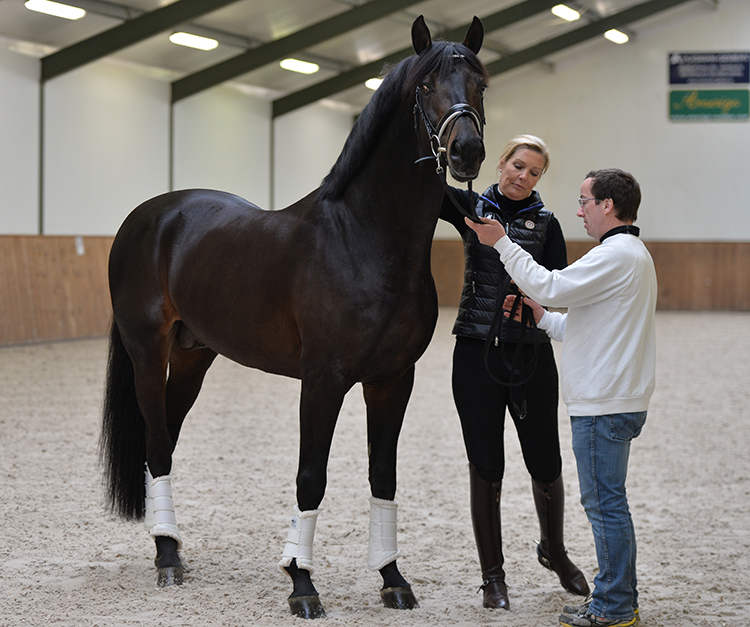
Lord Leatherdale
Lord Leatherdale by Lord Loxley/Ferragamo, born in 2003 and bred in the Rhineland by Zuchtgemeinschaft Pleines in Uedem, continues to be popular in the breeding of dressage horses. Among others, he is the sire of Glamourdale, the World Champion of Young Dressage Horses 2019.
Glamourdale
story continues below the advertisement
About the breeding principles
In the book ‘The KWPN Horse’ which was published by the KWPN in 2012, the breeding objectives and selection characteristics of the Dutch dressage horse are described in detail. The breeding goal is explicitly defined as striving to produce a horse that has the conformation and movement to be successful in Grand Prix.
Many criteria are similar to those in Hannover, but some accents are definitely set differently.
“Raising the forehand is one of the basics of dressage and that is why we prefer an upright (vertical) neck carriage in the dressage horse,” is the formulation in The KWPN Horse.
Great importance is also attached to the horses being constructed uphill and, above all, to them moving uphill, bringing the forehand up in the movement, having good self-carriage and being light-footed. For this they should be supple in the joints with an active hind leg and a bit of knee action.
What are the experiences in the Hannoveraner Verband with Dutch genetics?
(Editor’s note: I am sorry to give you a crick in your neck but this is the only way I know to present the information in a readable form)
In the Hannoveraner Yearbook Stallions 2021, the breeding values of nine KWPN dressage stallions are published and shown in the chart above. The estimated breeding values from the studbook evaluations confirm an overall positive heredity with regard to the conformation of horses. The average was 118 ranging from 91 to 143.
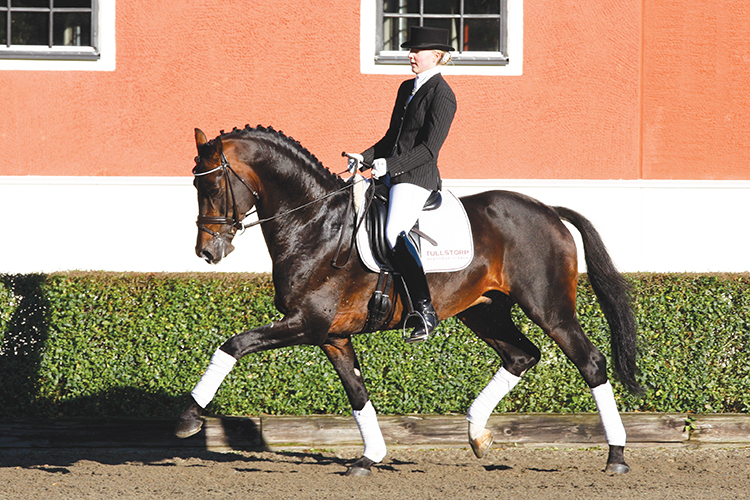
Ampère, 138 for type, 143 for conformation, 124 for canter, but 90 for walk, FN young horse value 141 (0.96 reliability), highest level achieved 148 (0.86)
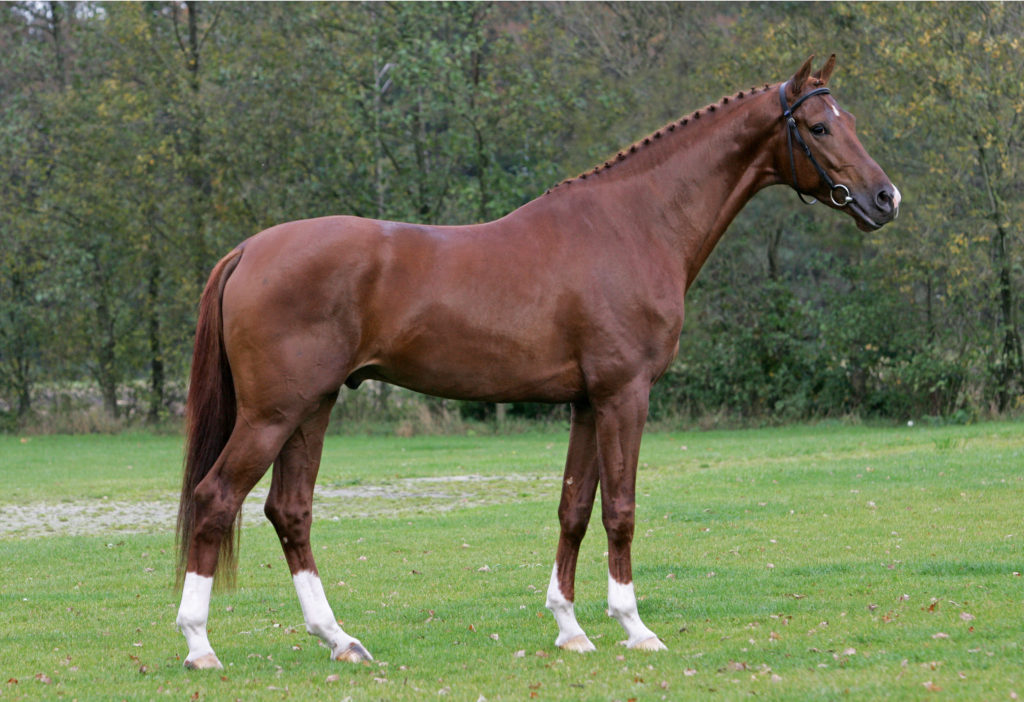
Vivaldi – 118 for type, but the best walk of the Dutch stallions, 112, FN breeding value for young horses, 150 (0.95) and for highest level achieved, 184 (0.82)
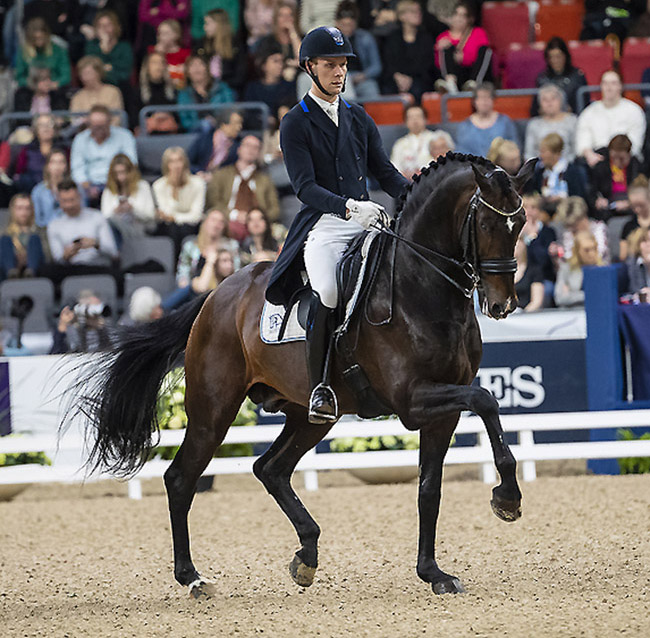
Zack, 132 for type, the best canter score, 130, and a good score for walk, 111 – FN breeding value for young horses 134 (0.96) and for highest level achieved 160 (0.88)
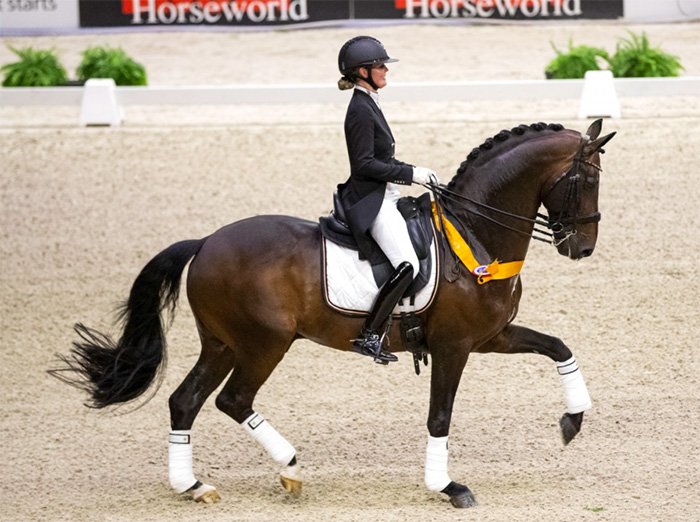
Bordeaux gets the lowest score for type, 90, but he is the third highest on the FN values for young horses, 143 (0.97) and the second highest for highest level achieved, 170 (0.90)
From a statistical point of view, these breeding values are quite well secured. Between 29 and 49 daughters per stallion were evaluated, the accuracy is between 0.78 and 0.86.
The Hannoveraner breeding value dressage is estimated from the assessments at the broodmare tests and from the evaluations at Verden’s auctions. The number of horses evaluated was between 13 and 52 per stallion, the accuracy between 0.68 and 0.88. Changes may still be expected in the breeding values, which show a low accuracy.
Of the breeding values for the basic gaits, the one for canter is the highest with an average value of 111 and a range of 87 to 130. Clear individual differences can be seen. The worst breeding value is the walk with an average value of 98 with a range from 81 to 112. The average values for trot (106) and rideability (105) are in between. The average overall dressage breeding value is 105 with a range of 94 to 119, which is rather sparse for potential dressage specialists.
The picture is completely different when looking at the sport based breeding values. The average FN breeding value for young horse tests (which includes results from stallion performance tests, broodmare tests and dressage horse tests) is 134 with a range of 117 to 150. Eight of these nine stallions already have a breeding value for “highest achieved class”, and the result is outstanding. The average breeding value is 157 with a range of 133 to 184.
story continues below the advertisement
Interpreting the results
From my impressions at mare performance tests, I can confirm that offspring of Dutch stallions are more often endowed with less swinging trot movements than the Hannoveraner or Rhineland mares. The canter often is the best gait, the walk the weaker gait.
Hannoverian Breeder, Ingo Pape
Could it be that the horses need more time in their development allowing their undoubtedly present talents to emerge? German breeder, Ingo Pape‘s comment fits this, “In the first phase under the rider, the Dutch horses often appear to be running. The movement is not very swinging. The horses then certainly need the influence of a suitable rider to add stability to the rhythm, as well as springiness and increased suspension to the movement, whose mechanics are labor-intense.”
It is fitting that the Hannoveraner breeding values, which are mainly based on the evaluation of three and four-year-old horses, are relatively low.
With increasing age and appropriate rider encouragement, the movement sequences are developed, resulting in higher horse show-breeding values.
Furthermore – just sufficient movement with less swing can be advantageous for the collection. A pre-disposition for Grand Prix does not require very big movement; the rideability of a Grand Prix-talent does not have to be easy. There are enough examples of successful Grand Prix horses, including Hannoveraner, that were difficult and required great riding skills.
In conversations with Hannoveraner breeders, there was scepticism about the use of KWPN stallions. The scepticism is based on self-made experiences.
Henning Schulze from Tiddische near Gifhorn, who is one of the larger breeders in the district association of Lüneburg, observed that rhythm and impulsion are often lost and the walk is not good enough. “But without a walk, I can‘t sell a dressage horse today,“ he says.
Herbert Kruse from Hamburg, also one of the larger and more successful breeders, who has already produced numerous licensed stallions such as Don Nobless, emphasizes the importance of rideability, “I need rideable horses that the recreational rider can also ride. The horses must be ‘clear in the head’ – that is the be-all and end-all.“ He sees deficits in this respect in many Dutch stallions.
Rudolf Schepergerdes from Meppen knows the market in Emsland very well. He is a successful breeder himself, but also the contact person for many foal buyers and sellers. “I see a decreasing interest in foals by KWPN stallions. Breeders tell me that starting the young horses is more complicated,“ he says.
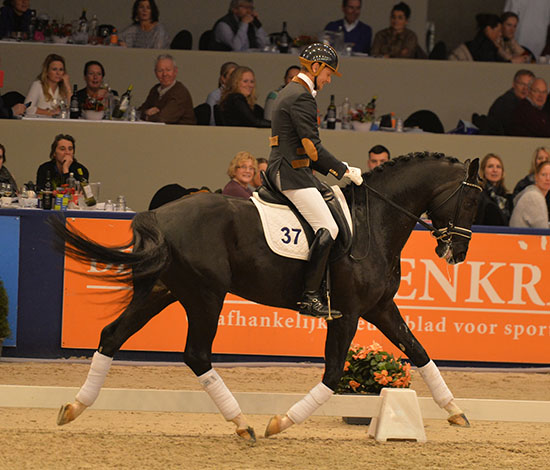
Toto Junior
But he has had good experiences with offspring of the Hannoveraner-bred Totilas son, Toto Junior, who is popular in the Netherlands.
“Many breeders in Emsland use stallions from the neighbouring country, to be able to offer different genetics than those, which everyone has,“ he adds.
Heinrich Behrmann, a successful and experienced Hannoveraner breeder from Stedebergen near Verden, is convinced of the Dutch way. Numerous licensed stallions come from his breeding, of which the great Bolero is best known.
“I really became aware of Dutch dressage horses at the World Championships for Young Dressage Horses in Verden in 2009 with the stallions Westpoint and Wynton. After that, I got involved with the Dutch studbook and the development of their sport horses. I came to the conclusion that they select more sharply. I have been using KWPN stallions in my breeding program for ten years.”
Don Juan de Hus
“It started with Don Juan de Hus, whom I saw for the first time in Hoya. The horse had an incredible aura and a top canter. I had two very good foals by him. He also confirmed his positive heredity with D‘avie FRH, the double World Champion of Young Dressage Horses bred by Dorothee Heitmüller, who I was allowed to raise. I have also had good experiences with Bordeaux. I am very convinced of Asgard’s Ibiza (Desperado / Jazz), by whom I have nine offspring so far. They are all super correct horses with a great charisma and good manners. For me, Ibiza as a sire is on the same level as Valentino xx and Absatz in the past, who have particularly influenced breeding in the Verden area.”
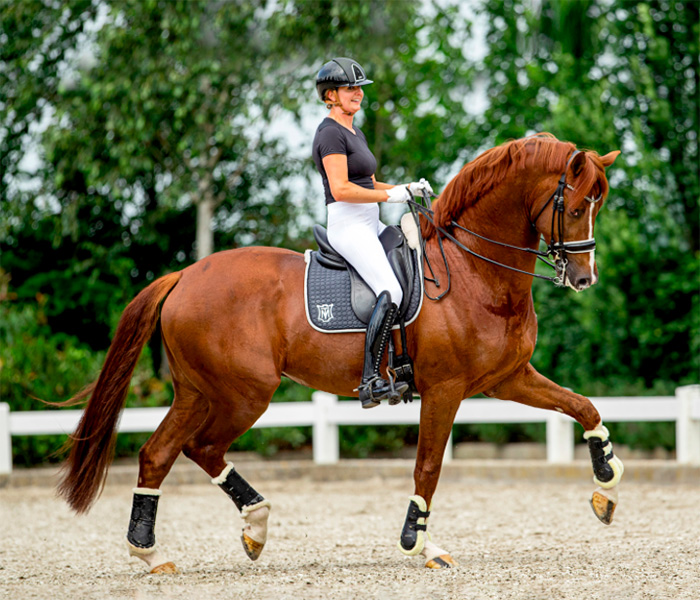
Asgard’s Ibiza (photo – Hengsthaltung Martin Determann)
“I analyse the dam lines very thoroughly before I use a stallion, because it is also true for the KWPN that not every horse is needed. There is a clear line in the selection of dressage horses in the Netherlands and selection process is very strict. The most important criteria are self-carriage, a stable topline, an active, diligent hind leg, correctness, good angulation of the front leg in the trot and light-footedness. The greatest value is placed on the canter. I remain Holland-minded.”
Arend Kamphorst is ‘Holland-minded’ almost by birth. Born in the Netherlands, he is one of the most successful Hannoveraner breeders with the Dree Böken breeding farm in Prieros, Brandenburg.
“I look around everywhere for the best stallions. With the KWPN stallions, I like the impressive front end, which – from my point of view – comes from the Groninger. However, I would like the walk to be better,“ he says.
Emma Blundell is a successful Hannoveraner breeder in England and, looking from the outside, has a no-nonsense view. She sees benefits in combining the advantages of German horses with those of the KWPN dressage horse.
Emma Blundell’s Mount St John Freestyle and Charlotte Dujardin at the WEG in Tryon
The trainers’ view
Matthias Klatt is Chairman of the Breeding Committee Dressage of the Hannoveraner Verband and is a successful dressage horse breeder in Hahausen (Harzvorland). He rides up to advanced S-level and is a sought-after trainer.
“For me, the German training scale stands above everything. The training goals associated with it cannot be achieved as quickly with many Dutch horses. The horses have to be ridden differently.”
Is there a different training philosophy in the Netherlands, is riding done differently there?
Matthias Alexander Rath, dressage rider and trainer at the breeding farm Schafhof in Kronberg, made his own experiences with Dutch horses (Totilas, Bretton Woods) and with German horses (Foundation, Destacado FRH). He is convinced that this question can be answered with ‘yes’.
Matthias Alexander and Totilas soon after the purchase of the stallion
“I have ridden in the Netherlands myself. Seat and influence are different. The horses are not constantly on the rider’s leg, as it is common in Germany, but they have to react to the leg all the more quickly.”
Johann Hinnemann knows the dressage sport in the Netherlands very well. He with his KWPN gelding Ideaal was Team World Champion with the German team in Toronto/CAN in 1986. He was one of the trainers of the dressage senior squad in the Netherlands in 2003 and 2004 and his expertise as a trainer is in demand worldwide. He answers the question about a different training philosophy in the Netherlands with a clear ‘no’.
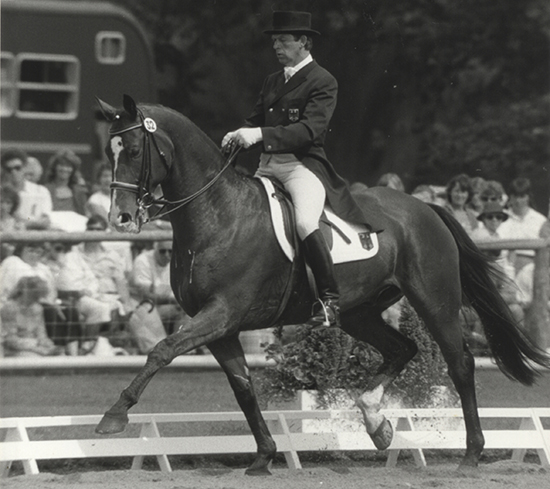
Johann Hinnemann and Ideaal
“The vast majority of riders in the Netherlands ride according to the same classical principles as in Germany. That doesn‘t rule out that there are individual black sheep, just like there are in Germany.”
He considers it a great responsibility for the judges to show, where the limits are. But that is a completely different topic.
Hans-Heinrich Meyer zu Strohen is a member of the Hannoveraner licensing commission, a trainer at Verden’s auctions, the national trainer of the junior and young rider squads and a sought-after dressage trainer. Comparing the mechanics in the movement, he likes the powerful push-off of Dutch horses. The impulsion of the (German) horse has advantages especially at a young age. A little less impulsion can definitely be an advantage for the piaffe, but not for the passage and for the lateral movements.
“In Hannover, the mechanics of the movement have much improved over the past ten years. In addition, the very good basic rideability is an absolute highlight of the Hannoveraner breeding program. When I am on the road internationally, I am often commended also by the Dutch for the great horses that we have for our young riders.”
Gonnelien Rothenberger competing for The Netherlands riding the Hannoverian stallion, Weyden. He was also competed by Sven.
The Rothenberger dressage stable in Bad Homburg has a lot of experience with both German and Dutch horses. Gonnelien Rothenberger, née Gordijn, comes from the Netherlands and was internationally successful for her home country.
Sönke Rothenberger and the Dutch-bred Cosmo at Aachen
Son Sönke collected the greatest successes with the Dutch-bred Cosmo (team gold in 2018 at the World Championships in Tryon/USA, Team European Champion in Rotterdam/NED in 2019); daughter Sanneke was U25 Individual European Champion in 2016 with the Oldenburg Deveraux and highly successful with the Hannoveraner Wolkenstein II daughter Wolke Sieben.
Sanneke Rothenberger and Devereux
The Rothenberger stable not only trains dressage horses, but also raises young horses, including horses acquired in the Netherlands. Sven Rothenberger, who also is highly successful in dressage – he won team silver and individual bronze at the Olympic Games in Atlanta/ USA in 1996 with the Hannoveraner stallion Weyden v. Westerland – rightly calls for not generalizing too much on the subject:
“One must not say that the Dutch horses have no walk. Totilas is a counter-example, he had a good walk himself and often passed it on. In general, I have had the experience that KWPN stallions pass on one thing and that is health. Here the consequent selection for this characteristic is noticeable. The most important criteria of a good dressage horse are a good canter, willingness to perform and willingness to go. And this is what I find in the Netherlands. If the willingness to go is too great, it can be difficult for less experienced riders. I think it is good that many of the best young stallions in the Netherlands stay with stallion owners and that these stallions are given the opportunity to prove themselves in competition. A society must have principles and these principles must be adhered to.”
Christoph Hess
The long-time head of the FN training department and the international dressage judge – often also in dressage horse competitions up to World Championships – Christoph Hess from Warendorf naturally also has his eye on the development in the neighbouring country:
“The Dutch are very pragmatic people. In the development of the KWPN dressage horse, they adjusted their breeding program according to what is needed for the Grand Prix. The movement is a bit shorter and is easily collected.”
Hannes Baumgart, member of the Hannoveraner licensing commission and dressage rider and trainer up to Grand Prix, furthermore sees changes in the Grand Prix tests, which could be advantageous for the Dutch way:
“The tests have been shortened considerably, giving more importance to piaffe and passage. For the mark for impulsion, the weighting has been reduced.”
Different origins and different breeding philosophies have produced different horses in the Netherlands and in Hannover. Above all, the Gelderlander was the basis of the breeding program in the Netherlands, a carriage-type horse with a high, impressive trot. In Hanover, besides suitability for agriculture, the focus has always been on suitability for riding.
The first stallion performance test, in which riding qualities were tested, existed almost 100 years ago. Here the suitability as remounts for the military was of utmost importance.
In the book “Der Hannoveraner“ (The Hannoveraner) from 1967, the then Managing Director and Breeding Director of the Hannoveraner Verband, Dr. Arnold Schlie, wrote: “Typical for Hannover… is the flat style of movement in the front extremities… In Hanover it is agreed that the round gait caused by more or less, knee action is more conspicuous but less practical and less pleasant for the rider. The elasticity suffers, the tendons and ligaments are more stressed and the stride becomes shorter.”
So in The Netherlands, the task was to develop riding qualities and thus elasticity and relaxedness in all three basic gaits. In Hannover, the aim in the past decades was to meet the demands of the sport and thus also the demands of the market for higher movement without losing elasticity, relaxedness and a good walk. In the Netherlands, the reorientation of the sporthorse breeding program was geared towards the Grand Prix as its breeding goal right from the start. The specifications for conformation and movement were adjusted accordingly. The diligence in the movement and the quick push-off of the legs without losing the rhythm are important.
In Germany, the breeding goal for the dressage horse is more general. In the forefront are swinging, relaxed and elastic movements, which were, especially in the past, sometimes a little slow, and well as good rideability with an equally good feel for the rider in the saddle. A Grand Prix horse is developed through consistent training in accordance with the guidelines of the training scale.
Whether or not it is possible to breed a Grand Prix horse was, and sometimes still is, a controversial issue. The breeders in the Netherlands, but also the experiences in Germany especially – but not only – with the line of Donnerhall, show that this discussion can be put to sleep. Grand Prix as a breeding goal works.
However, previous experiences with Dutch bloodlines, and to a degree also with other bloodlines, show that focusing on breeding a Grand Prix-specialist does not necessarily result in an improvement of the rideability across the board. An awareness that the horses do not become more complicated and difficult is important.
The Hannoveraner is popular all over the world, especially because of its positive interior and its rideability characteristics. These must be preserved, without losing sight of the goal of supplying horses for top international competitions.
Maryanna Haymon, a successful Hannoveraner breeder from the USA, once answered the question about her personal breeding goal as follows, “My goal is the amateur-friendly Grand Prix horse.” With her breeding philosophy, which focuses on her Hannoveraner Donnerhall/Prince Thatch xx son Don Principe, she has achieved this ambitious goal several times.
The Breeding Committee of the Hannoveraner Verband has decided to start an “Initiative Grand Prix“ and thus underlines the importance of strengthening the focus on the Grand Prix-horse in the breeding of Hannoveraner dressage horses. In this project, the sport-proven Dutch genetics will be valuable.
Klaus Storbeck, a Hannoveraner breeder and dressage judge from broodmare tests to Grand Prix, says, “The mixture makes the difference. A well-considered use of KWPN stallions can be positive.”
So it will be about combining the strengths of Dutch and Hannoveraner genetics. Horses like Toto Junior or most recently the Hannoveraner and Bundeschampion Va‘Pensiero prove that fascinating horses can come out of this. However, the breeder must know his expectations from the combination. As with every stallion selection, by the way …
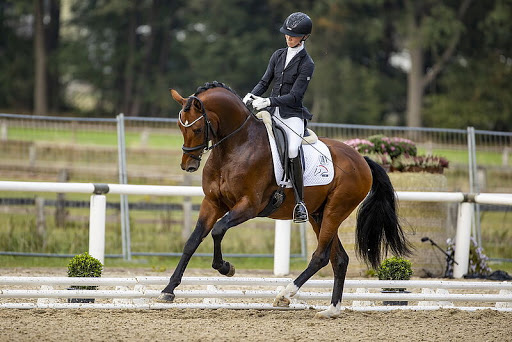
Va‘Pensiero (Vitalis / Fürstenball) – photo credit: Equitaris
Comments from an expert panel:
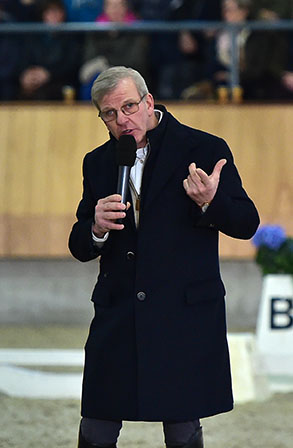
Johan Hamminga is a member of the KWPN licensing commission and an experienced dressage trainer up to the Grand Prix-level. DER HANNOVERANER: Where do you see the Dutch and the German dressage horse breeding program?
Johan Hamminga, “We are looking for a rideable horse with a lot of basic quality that can make it to the big arena. The KWPN has invested a lot in health and correctness of the horses and thus also in usability. You can have a very nice, good horse, but if he does not have a proper foundation (correct hooves and legs) and is not sound, he won‘t go far.”
DER HANNOVERANER: As this year‘s licensing showed, the KWPN continues to use German stallions. What should be improved with the use? Are there any preferred lines?
Johan Hamminga, “We need German blood for more frame and to maintain the blood diversity in the breeding of dressage horses. So far, we have had good experiences with the offspring of Donnerhall and Rubinstein. For example, with De Niro: As the sire of Desperados, he is also represented in Glock‘s Toto Jr, who now successfully competes at the Grand Prix-level and who has proven himself as a producer. We furthermore would like to maybe use stallions out of the Hannoveraner B-line. Last year, Bloomberg FS, a son of Bon Coeur, was the winner of the stallion performance test in Ermelo.”
DER HANNOVERANER: How important are the walk and the relaxedness in the KWPN breeding program?
Johan Hamminga: “Walk and relaxedness are very important topics for us. In the past years, the KWPN has applied a strict selection process to the walk. We have managed to improve the walk in a few years. For us, a good walk flows through the entire body and creates a relaxed movement. In the Netherlands, however, we talk about a ‘German’ or a ‘Dutch’ walk. For us, it is most important that the walk is active and in a clear four-beat rhythm, that it flows through the whole body and and creates an over-stride by about the length of three hooves. My experience as a trainer has taught me that a horse with such a walk has more reaction in its body and can learn starting the piaffe easier and faster from this walk (with not too much overstride).”
Emma Blundell
Emma Blundell has built up the Mount St. John Stud in Yorkshire in the north of England, where around 50 foals are born every year out of the best German and Dutch dressage lines. The breeding goal is the Grand Prix. She compares these different dressage horse breeds:
“The KWPN horses often have a natural uphill conformation with often quite vertical, high-carried necks and a lot of energy and power, which is of course very helpful for the Grand Prix. These characteristics can cause difficulties in the early years. The horse might be more looky and therefore have less of an over-stride in the walk, because the horse is not as relaxed and does not use its back in the movement as it could. I often think that the young Dutch horses are ridden with a lot of pressure.”
“I do, however, think that they have a lot of energy. It is probably not so easy for them to relax and walk on a longer rein, as, for example, the young German horses do. These are often more horizontal in their topline and naturally exhibit more swinging in the back, perhaps with softer and slower hind legs. Because of these characteristics, these horses are often more comfortable to sit to, and it is easier for them to become relaxed and show length in their strides. Through training, these horses develop their carrying power in the hindquarters, becoming quicker in their reactions and more uphill. Therefore, the training system to get a German horse to the Grand Prix level is very different from that of a KWPN horse.”
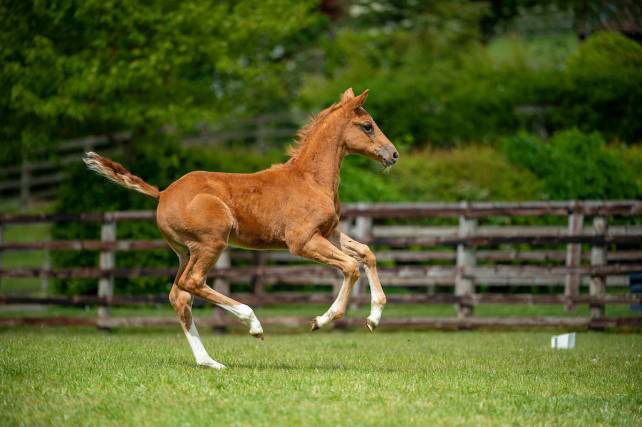
An example of the fusion at Mt St John – MSJ Verco – the pedigree goes Vitalis, Negro, Donnerhall. This foal was sold to Canada…
“Most of our mare base is German, therefore I sometimes choose Dutch stallions for these mares to improve the uphill tendency and the speed of the reactions. Vice versa, on some of my Dutch mares that are more vertical in the neck and more gripping, I choose a more buoyant, powerfully moving German stallion, which I know has high rideability and naturally uses his back, while I pay particular attention to the horse’s walk and his ability to relax. I make these crosses believing that I can combine the best of both worlds.”
“Fortunately, as a Brit, I don‘t have a nationalistic bias towards one or the other. I simply want to breed – as best I can – the best future sport horses for Grand Prix. In doing so, I focus on the strengths and weaknesses of each mare to achieve breeding progress for the next generation.”
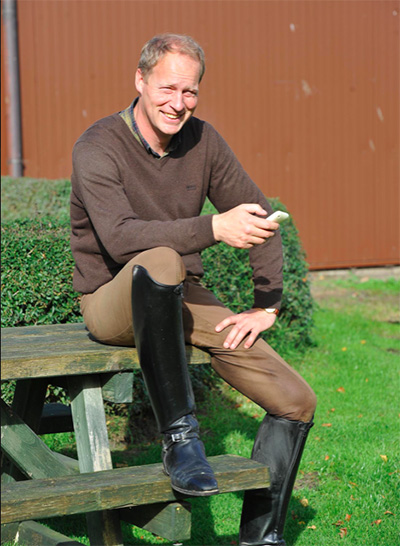
Ingo Pape
Ingo Pape, a well-known breeder, trainer and stallion owner, always keeps an eye on the development in the Netherlands. On the mechanics of the movement: “In the first phase under the rider, the KWPN horse often appears to us to be rushing and not exhibiting much swing. The horses then certainly need the influence of a suitable rider, who adds a steady rhythm, springiness and an increased suspension phase to the mechanically complex movement. Top horses must basically be able to move big and small in all three gaits. Therefore, in my experience, it is easiest to train horses that have a medium gait volume but great flexibility and suppleness. Having absolutely no swing in the movement is certainly not an advantage with regard to the collection later, as for instance the passage requires a lot of swing.”
Regarding rideability: “A neck, which is carried too high due to the exterior of the horse, certainly does not make it easier for the rider to work the horse over its back. Even though Jazz, who is widely spread in the Netherlands, certainly was an exceptional sire, one can see this predisposition in many of his offspring. If this is combined with a lack of relaxation, it often becomes really difficult for the less experienced rider to reach his goals. This is where our Hannoveraner horses have a clear advantage across the board. This is especially true for the amateur sport, which makes up the largest part of the market to be served.”
“Competitions are always decided in the mind. Therefore, being relaxed inside must always precede the outer relaxedness. What we should strive for in breeding horses is a positive sensitivity, out of which a suitable trainer can then develop increased cadence and thus charisma. Just ‘being good’ does not work for the tougher sport, neither does over-sensitivity. Basically positive qualities such as a great willingness to walk, strength, a good constitution and sensitivity can complicate things for less experienced riders at the beginning of the training process. However, these are exactly the qualities that are essential for a top horse.”
“So, as is so often the case, it all comes down to the right balance. I believe, however, that this problem has been recognised in the Netherlands and that countermeasures are being taken. Improved composure will certainly also make it easier to better present the horses at the walk.”
On the breeding goal: “If you want to breed horses for top dressage competitions, the talent for collection is absolutely crucial. Willingness and ability for collection make the difference between a recreational athlete and a top horse. The KWPN recognized this early on and clearly defined breeding goals to that effect. It is very difficult to take into account the breeding selection on the mare side, because the predisposition for collection and the required strength for it can only really be assessed, once the mare is six years of age or older. By then, most mares are already in foal. Therefore, it is all the more important that the stallions are willing and capable of collection.”
“Also in my function as a stallion owner, I have the greatest respect for the consistency, with which the KWPN and my Dutch colleagues have brought almost all line-founding or highly influential stallions into the international top sport. Jazz, Ferro, Cocktail, Krack C, Partout, Gribaldi, Johnson, Totilas, or Apache are just a few examples. In Germany, we have actually only managed to do this to a sufficient degree with the D-line (Donnerhall, Desperados, De Niro, Don Schufro, Damsey, Don Nobless). Besides, this verifies and confirms the toughness that is needed for the top sport. Toughness is a huge breeding issue and certainly cannot be defined by any X-ray findings. Since the sport ideally tests the qualities, which are needed in a breeding stallion, the Dutch concept should serve as an incentive for all of us in this respect. I am convinced that this is one of the keys of the KWPN‘s success in the targeted breeding of Grand Prix horses.”
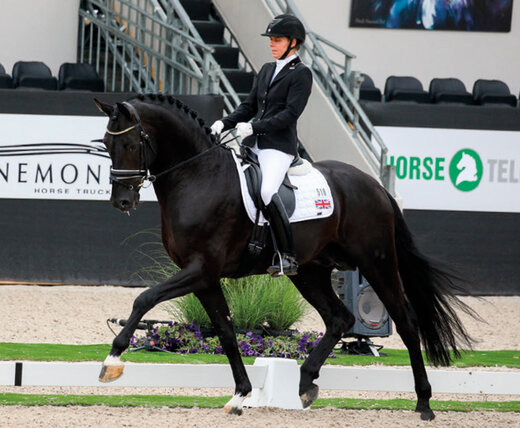
The fusion in action – one of the Pape stallions, V-Plus. His topline is all Dutch:Vivaldi/
Krack C/Jazz/Ulft and the damline, all German: Fürst Romancier/Sandro Hit/ Landadel
ends

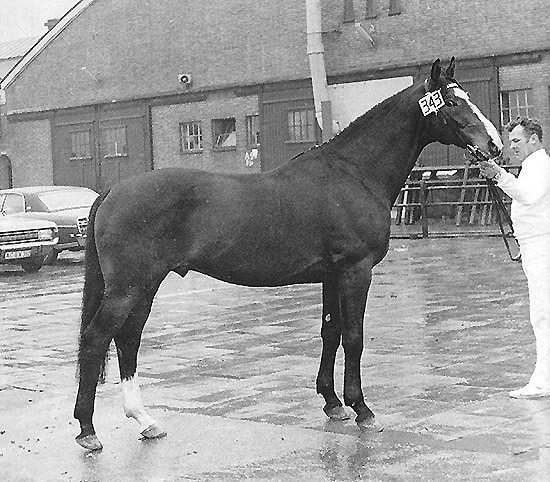
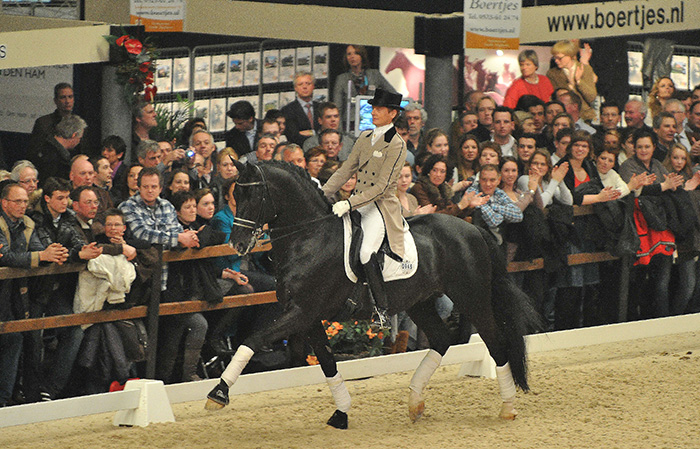
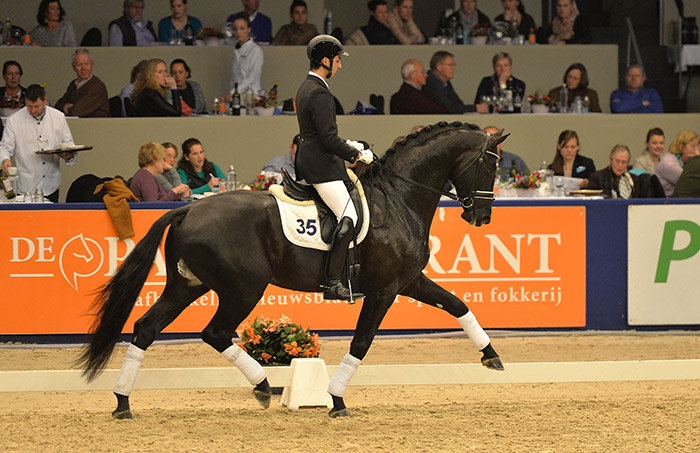
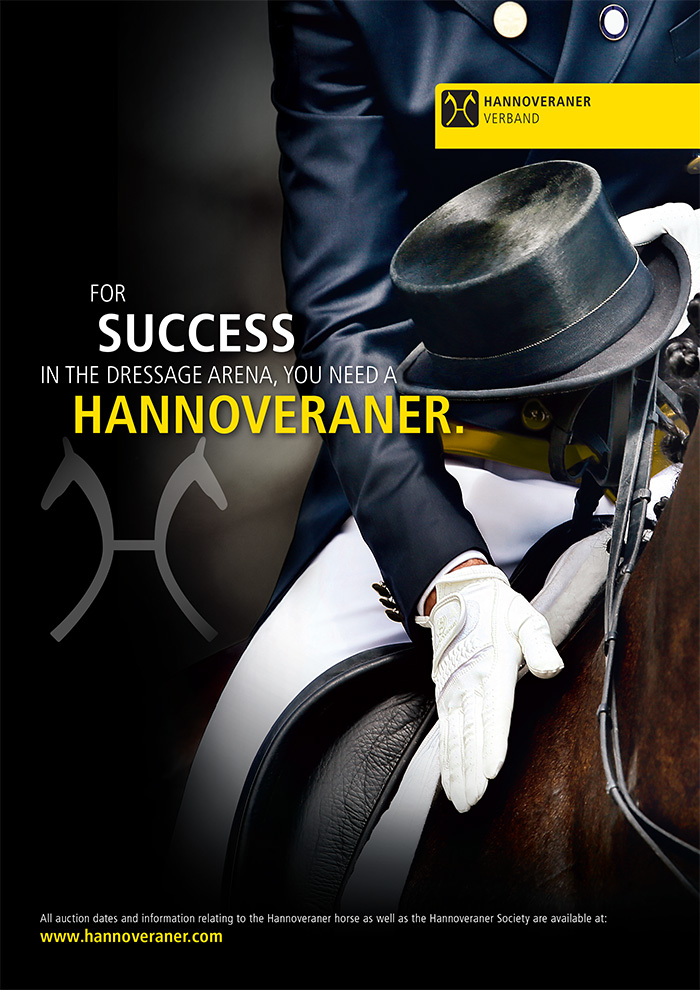
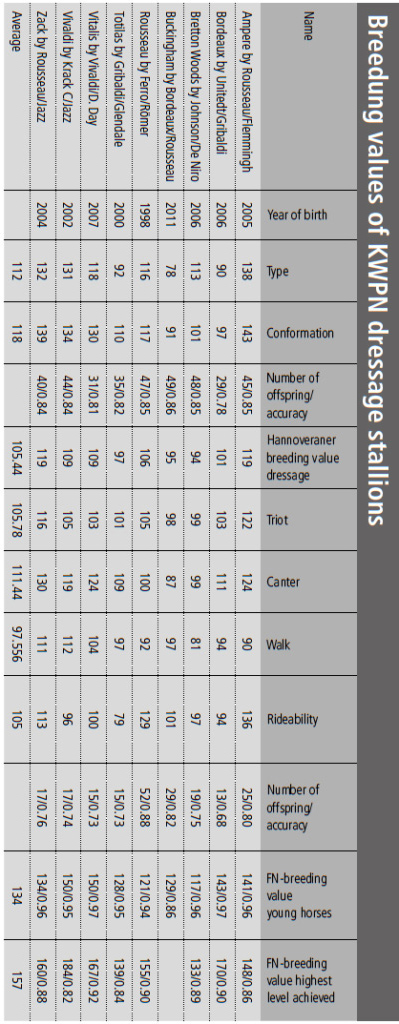
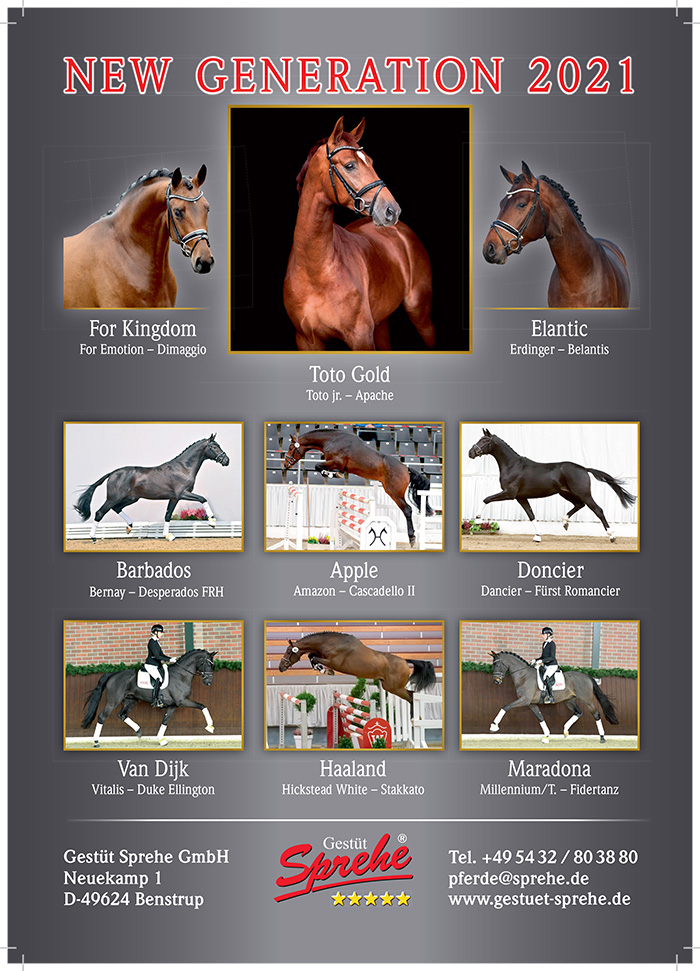
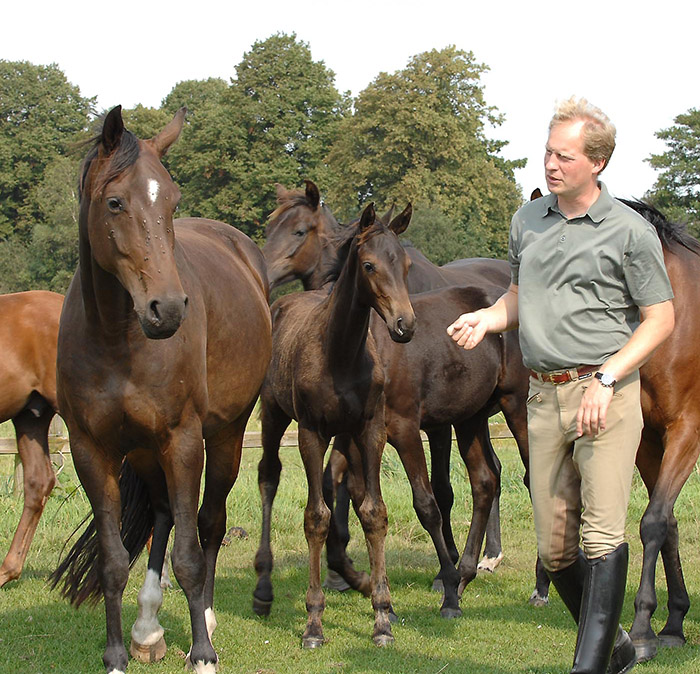
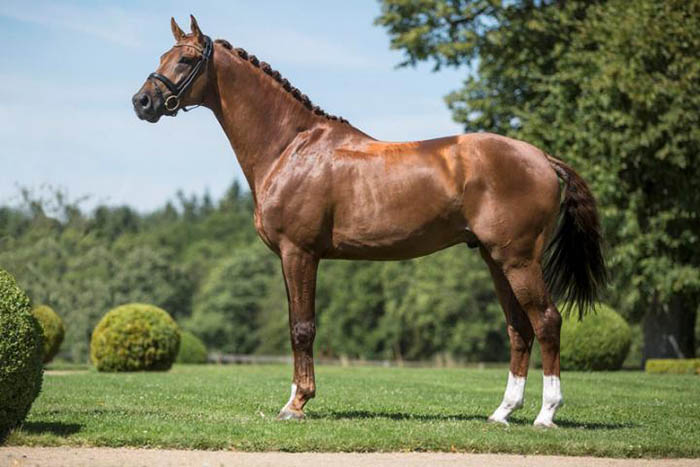
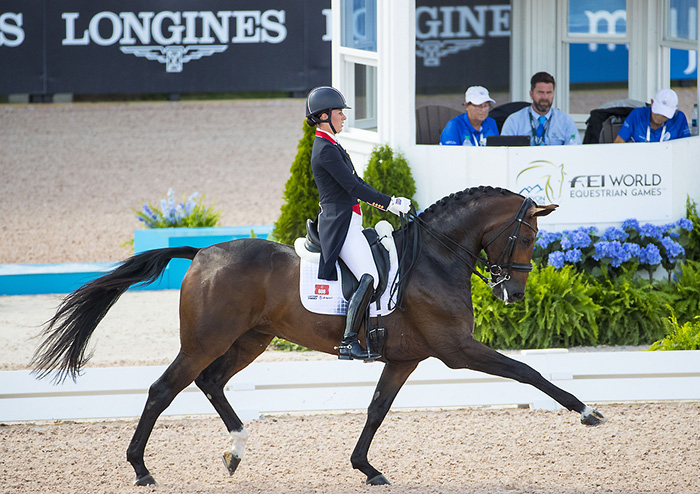
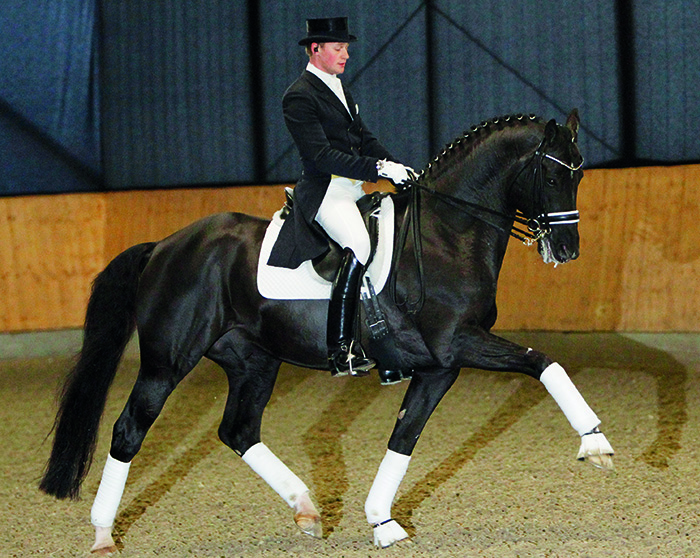
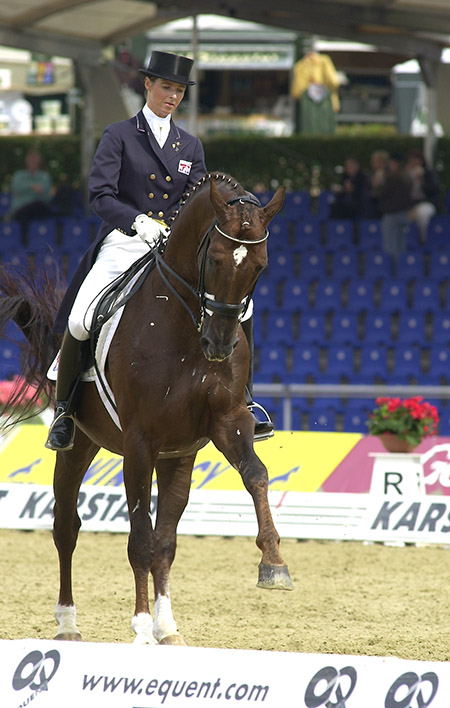
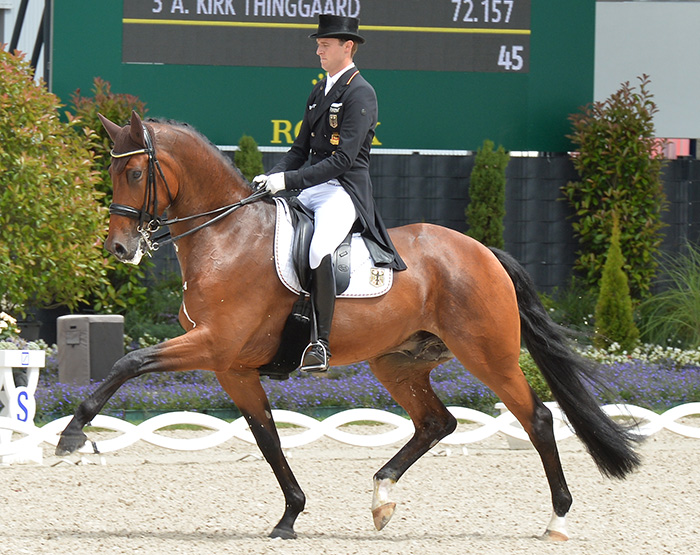
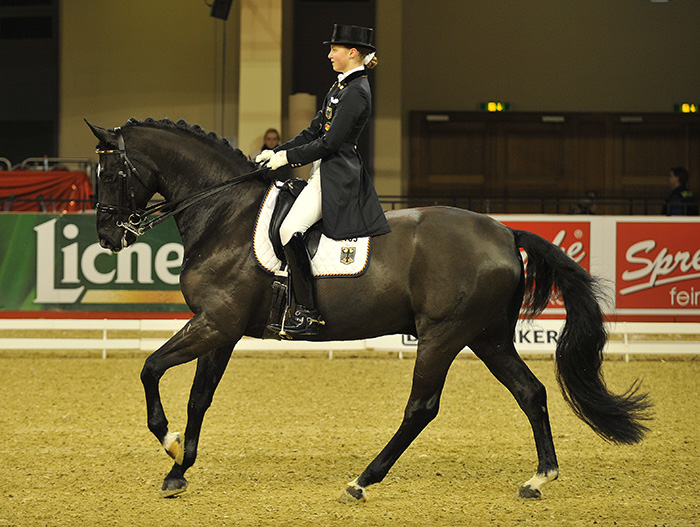
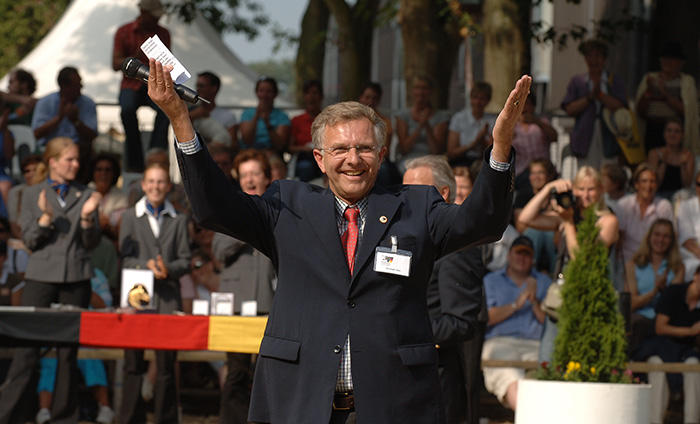
Nice article with sound arguments & good depth! Seldom we see this level passing by nowadays (certainly on the internet)